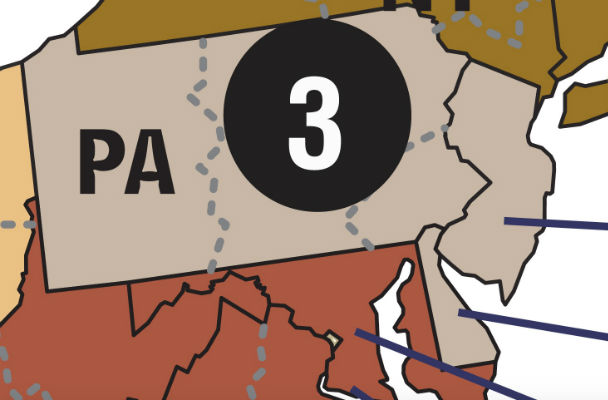Third Circuit Affirms Surface Miner’s Award of Benefits as Supported by Substantial Evidence (PBS Coals, Inc. v. Director, OWCP [Davis])

Somewhat similar to the recent Sixth Circuit decision covered yesterday, last week the U.S. Court of Appeals for the Third Circuit also affirmed a surface miner’s award of federal black lung benefits. (Thanks to Steve Breeskin for informing me of the decision.)
PBS Coals, Inc. v. Director, OWCP [Davis], No. 14-4089, 607 F. App’x 159 (3d Cir. July 20, 2015) (slip opinion here) involved a subsequent claim by a Pennsylvania coal miner who worked on surface mines for twenty-four years (the decisions do not discuss the dust conditions).
The Third Circuit—per Judge Greenaway (and joined by Judges Smith & Shwartz)—issued an unpublished decision that quickly rejected the company’s argument that its evidence satisfied its burden to “rule out” coal-mine employment as a cause of the miner’s disability.
The opinion had one paragraph that decided the case:
Under Third Circuit precedents, in order to rebut a presumption of pneumoconiosis . . . the party opposing the award of benefits must ‘rule out a possible causal connection between a miner’s disability and his coal mine employment.’” Plesh v. Dir., OWCP, 71 F.3d 103, 113 (3d Cir. 1995) (quoting Kline v. Dir., OWCP, 877 F.2d 1175, 1179 (3d Cir. 1989)).5 PBS argues that the testimony of its experts Dr. Gregory Fino and Dr. Peter Kaplan satisfied its burden to “rule out” coal dust exposure as a cause of Davis’s disability. However, this is directly contradicted by the expert testimony itself. Dr. Fino testified that the effect of coal mine dust was “not clinically significant” but that it “may be contributing [to] a numerical reduction in FEV1.” App. 88. On cross-examination, Dr. Kaplan testified that coal dust contributed to “ten percent” of Davis’s disability. App. 165–66.
5 The language of the regulation applicable here requires a showing that “no part of the miner’s respiratory or pulmonary total disability was caused by pneumoconiosis.” This language is effectively identical to the regulatory language at issue in Plesh; as such the “rule out” standard applies. See W.Va. CWP Fund v. Bender, 782 F.3d 129, 133–35 (4th Cir. 2015); Antelope Coal Co./Rio Tinto Energy Am. v. Goodin, 743 F.3d 1331, 1337 (10th Cir. 2014).
slip op. at 3–4 (footnote 6, which simply defined FEV1, omitted) (emphasis in original).
Because the decision is unpublished, its precedential weight in the Third Circuit is weak (the Third Circuit’s internal operating procedures suggest an especially low-weight for unpublished opinions).
However there are a couple things that stand out about the operative paragraph that warrant attention.
First, the court’s decision makes clear that etiology statements like “not clinically significant” or “ten percent” are not enough to rule out coal-mine employment as a contributor to a respiratory disability. The case demonstrates that the Third Circuit recognizes that even insignificant contribution is still contribution.
Second, the court’s decision is notable with respect to the Benefits Review Board’s recent published decision in Minich v. Keystone Coal Mining Corp. In PBS Coals, the Third Circuit noted the existence of the amended regulation at 20 C.F.R. § 718.305(d)(1) that clarifies the rebuttal standard, but stuck to its language from Plesh saying that disability causation had to do with ruling out a relationship between disability and coal-mine employment. It is notable that in Minich the Benefits Review Board applied Third Circuit law and vacated an ALJ decision that used the same approach. (As discussed in a previous post, in Minich the Board remanded to the ALJ to clarify that disability causation has to do with the relationship between disability and pneumoconiosis NOT coal-mine employment.) PBS Coals thus suggests that the Board’s remand in Minich is not the direction that the Third Circuit would have taken. Future Third Circuit cases involving decisions that analyze disability causation by referring to coal-mine employment may need to resolve the tension between the unpublished decision Third Circuit decision in PBS Coals and the published Board decision in Minich.
One notable fact about the case is that Administrative Law Judge Swank first found that Mr. Davis affirmatively proved the existence of clinical pneumoconiosis before applying the fifteen-year presumption to the case for purposes of assessing disability causation (ALJ decision here). This unusual methodology affected review before the Board and caused the Board to reject the Director’s argument that the ALJ erred in his rebuttal assessment of legal pneumoconiosis; the Board held that because clinical pneumoconiosis was affirmatively proven, this precluded rebuttal by proving that legal pneumoconiosis did not exist (BRB decision here).
PBS Coals, Inc. and Rockwood Casualty Insurance Co. were represented by Sean B. Epstein and Lee A. Rhodes of Pietragallo, Gordon, Alfano, Bosick & Raspanti (Pittsburgh, PA).
Kenneth A. Davis was represented by Heath M. Long of Pawlowski, Bilonick & Long (Ebensburg, PA).
The Director, OWCP did not participate in the appeal.
One Response to “Third Circuit Affirms Surface Miner’s Award of Benefits as Supported by Substantial Evidence (PBS Coals, Inc. v. Director, OWCP [Davis])”
Thanks for summarizing these cases Evan……..great job!
Comments are closed.